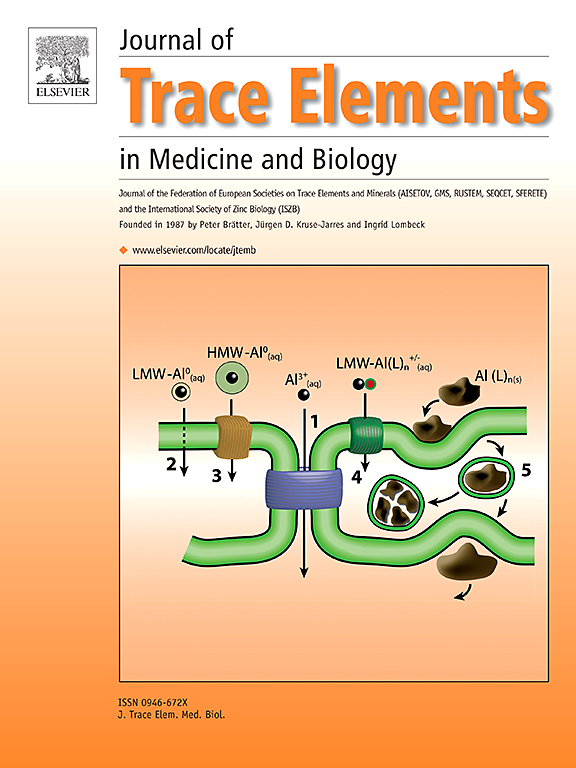神经生长因子在铜诱导肝损伤的p38 MAPK通路中起调节作用
IF 3.6
3区 医学
Q2 BIOCHEMISTRY & MOLECULAR BIOLOGY
Journal of Trace Elements in Medicine and Biology
Pub Date : 2025-07-08
DOI:10.1016/j.jtemb.2025.127694
引用次数: 0
摘要
铜(Cu)毒性可诱导肝细胞氧化和亚硝化应激,导致炎症和细胞凋亡。神经生长因子(NGF),以其神经保护特性而闻名,可能通过p38 MAPK途径影响肝组织;然而,其在cu诱导的肝毒性中的作用尚不清楚,因此本研究的目的是研究外源性NGF在cu诱导的小鼠肝损伤模型中的保护作用,重点关注p38 MAPK途径。方法雄性成年BALB/c小鼠64只,随机分为8组,每组腹腔注射3次,每次间隔24 h,注射剂量如下:0.9 %氯化钠(控制),10 µg / kg神经生长因子(神经生长因子),20 毫克/公斤SB203580 (p38MAPKi), 10 µg / kg神经生长因子+ 20毫克/公斤SB203580(神经生长因子+ p38MAPKi), 20 毫克/公斤CuSO₄(铜),20 毫克/公斤CuSO₄+ 10 µg / kg神经生长因子(铜+神经生长因子),20 毫克/公斤CuSO₄+ 20毫克/公斤SB203580(铜+ p38MAPKi)和20 毫克/公斤CuSO₄+ 10 µg / kg神经生长因子+ 20毫克/公斤SB203580(铜+神经生长因子+ p38MAPKi)。采用组织病理学、免疫组织化学、生化和分子方法分析肝组织。结果scuso4暴露引起严重的肝损害,表现为水肿变性、局灶性坏死和细胞凋亡(Caspase 3和8)升高。它还增加了ALT/AST水平和氧化/亚硝化应激标志物(MDA、TOC、iNOS、硝基酪氨酸),同时降低了抗氧化标志物(GSH、TAC)。NGF可显著改善这些改变,改善抗氧化状态,降低促炎细胞因子(IL-1、IL-6、TNF-α)。通过与SB203580共处理,这些影响被消除,暗示p38 MAPK参与。结论ngf通过p38 MAPK信号通路调节氧化应激、炎症和细胞凋亡,对铜诱导的肝毒性具有保护作用。这些发现强调了NGF作为氧化性肝损伤治疗候选药物的潜力。本文章由计算机程序翻译,如有差异,请以英文原文为准。
Nerve growth factor acts as a modulator on the p38 MAPK pathway in copper-induced liver damage
Background
Copper (Cu) toxicity induces oxidative and nitrosative stress in hepatocytes, leading to inflammation and apoptosis. Nerve Growth Factor (NGF), known for its neuroprotective properties, may influence liver tissue via the p38 MAPK pathway; however, its role in Cu-induced hepatotoxicity remains unclear, and hence the aim of this study is to investigate the protective role of exogenous NGF in a Cu-induced liver injury model in mice, with a focus on p38 MAPK pathway.
Methods
Sixty-four adult male BALB/c mice were equally divided into eight groups, with each group receiving intraperitoneal injections 3 times at 24 h intervals of their respective substances at the following doses: 0.9 % NaCl (Control), 10 µg/kg NGF (NGF), 20 mg/kg SB203580 (p38MAPKi), 10 µg/kg NGF + 20 mg/kg SB203580 (NGF+p38MAPKi), 20 mg/kg CuSO₄ (Cu), 20 mg/kg CuSO₄ + 10 µg/kg NGF (Cu+NGF), 20 mg/kg CuSO₄ + 20 mg/kg SB203580 (Cu+p38MAPKi), and 20 mg/kg CuSO₄ + 10 µg/kg NGF + 20 mg/kg SB203580 (Cu+NGF+p38MAPKi). Liver tissues were analyzed using histopathological, immunohistochemical, biochemical, and molecular methods.
Results
CuSO₄ exposure caused severe hepatic damage, evidenced by hydropic degeneration, focal necrosis, and elevated apoptosis (Caspase 3 and 8). It also increased ALT/AST levels and oxidative/nitrosative stress markers (MDA, TOC, iNOS, nitrotyrosine), while reducing antioxidant markers (GSH, TAC). NGF administration significantly ameliorated these alterations, improved antioxidant status, and reduced pro-inflammatory cytokines (IL-1, IL-6, TNF-α). These effects were abrogated by co-treatment with SB203580, implicating p38 MAPK involvement.
Conclusion
NGF exerts hepatoprotective effects against Cu-induced toxicity by modulating oxidative stress, inflammation, and apoptosis through the p38 MAPK signaling pathway. These findings underscore NGF’s potential as a therapeutic candidate for oxidative liver injuries.
求助全文
通过发布文献求助,成功后即可免费获取论文全文。
去求助
来源期刊
CiteScore
6.60
自引率
2.90%
发文量
202
审稿时长
85 days
期刊介绍:
The journal provides the reader with a thorough description of theoretical and applied aspects of trace elements in medicine and biology and is devoted to the advancement of scientific knowledge about trace elements and trace element species. Trace elements play essential roles in the maintenance of physiological processes. During the last decades there has been a great deal of scientific investigation about the function and binding of trace elements. The Journal of Trace Elements in Medicine and Biology focuses on the description and dissemination of scientific results concerning the role of trace elements with respect to their mode of action in health and disease and nutritional importance. Progress in the knowledge of the biological role of trace elements depends, however, on advances in trace elements chemistry. Thus the Journal of Trace Elements in Medicine and Biology will include only those papers that base their results on proven analytical methods.
Also, we only publish those articles in which the quality assurance regarding the execution of experiments and achievement of results is guaranteed.

 求助内容:
求助内容: 应助结果提醒方式:
应助结果提醒方式:


